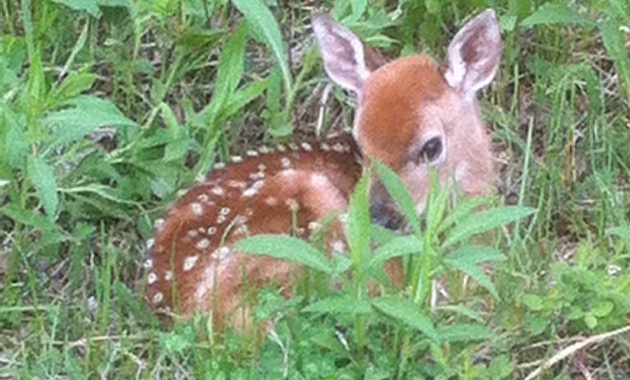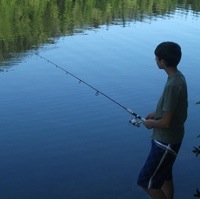As we venture into the backcountry, it is important to respect and understand the residents of the wild. Unexpected encounters can be positive or negative, based upon the choices of humans. Too often animals are put into a compromising position when we interfere with their natural flow of life. We absolutely must release the fantasy of domesticating wild animals. I am a perpetual animal lover, but we must draw the line between domesticated and wild to ensure backcountry access and the protection of the wildlife that surrounds us.
Here are some tips to help us all tread lightly while we enjoy motorized recreation in the backcountry.
Deer
In an attempt to do the right thing, many people unintentionally put fawns in harm's way. Believing they are abandoned, humans intervene and reach out to rescue these little sweethearts.
Back away from the fawn, literally. They are not abandoned, they are stashed away by their mothers in the attempt to keep them protected. Fawns are born scentless, a wonderful protective cloak of invisibility. They can go undetected for hours, until Mom comes back to feed and nurture them. They’ll lie still in the vegetation, camouflaged. This protects them from stalking predators.
The doe will only visit her fawn a few times a day, to avoid drawing attention to her young one. Do not touch the deer. Leave the area quickly, and be sure to contain your pets so as not to disturb the fawn.
Recently many deer cull initiatives have taken place when deer have become too accustomed to life in townsites. A deer in the backyard is cute at first, but the reality of the situation is far less endearing. The deer become less skittish about human contact and in many cases become overly aggressive, even attacking the residents of the towns. We must keep wild wild. We are their worst enemies, even when our hearts seem to be in the right place.
Moose
Moose are incredibly aggressive, especially cows pregnant or with young. Moose are responsible for more attacks on humans each year than bears. They will charge and lash out if they feel cornered or threatened. Many people underestimate the aggressive nature of a moose and find themselves in a predicament, head on with a moose.
This happened to my children and me one year when we were out sledding. We were on a logging road with a steep cliff on the high side and a steep cliff off the low side. The moose was ahead of us about 100 yards. We stopped to give him room to go on his way. Instead the moose charged.
I had four children in a skimmer behind my snowmobile and one on the seat behind me. I did what any mother would do: I let out a big Xena war cry, which stopped him in his tracks. He lowered his head, snorted, then shifted his body—indicating he again was going to charge. I stood on my seat and revved my motor while all the children let out war cries. I told them to all stay with me. No one goes out of the skimmer! Hearing all of us and the revving of our motor, combined with my lights, he stopped again and changed direction away from us. We gave him ample time to move forward before we attempted to turn around.
We saw that moose several times throughout the spring and summer of that year. He was so huge we called him the moose-a-saur.
Give moose plenty of space to leave the area peacefully and without stress. Never approach a cow moose and her young. Never chase a moose or any other species of wildlife. They need the precious calories, throughout winter especially. So although they can be lethal, they still deserve respect—for we are riding in their backyard, not ours.
Bear
Normally a bear will hear our machines coming and vacate the area without incident. Sometimes we’ll stop to picnic or berry pick and encounter bears. Noise is your friend and a deterrent to bears, so when in the backcountry populated by bears, please make lots of noise.
Take notice of any bear sign on the trail, including scat, tracks, overturned rocks, rotten trees torn apart, and fresh diggings or trampled vegetation. If you notice signs of a kill, circling ravens, or the smell of a rotting carcass, immediately leave the area. The predator will most certainly not be far away.
If you do encounter a bear, it is important not to panic. The least likely to attack is a black bear. Grizzlies are far more aggressive, but that being said, black bears can be very dangerous. If they lose their fear of man they become brazen and territorial, making attacks more likely.
If you are unnoticed by the bear, back slowly away when the bear isn’t looking in your direction. Keep your eyes on it, but do not make eye contact, as this can be interpreted as a challenge. Slowly vacate the area.
If you are noticed, do not panic. Try to look big, with arms stretched up. Speak in a low tone and move slowly away, keeping your eyes on the bear without making direct eye contact. If the bear is standing up, he is trying to identify you, not necessarily being agressive, so talking will help you to be identified as human.
If the bear begins a low growl, chomping or woofing, that is an aggressive signal. Do not run (food runs!) but move slowly away. If you have a pack, drop it. This may serve as a distraction for the bear, allowing you time to get away.
Bear spray is a repellent used to deter a charging bear. Know how to use your spray, as many an unsuspecting user has accidentally sprayed himself. This spray is for close range situations.
Bear bangers are similar to firecrackers, creating a loud bang to scare away an aggressive bear. They can be tempermental when wet. They are meant to be used in between you and the bear. Do not set one off behind the bear or you may send that bear charging in your direction.
A fog horn is a much safer alternative, creating a loud, obnoxious sound that will send the bear running. Quite often I’ll set off a blast or two when we’ve reached a destination, be it a berry patch or a creek to fish at. Deep in the woods, I want everything to know I am there, as a surprised bear is not a good situation.
Bear bells are another way to alert bears of your presence, giving them the time to leave the area. Any noise works well, including singing and talking.
My children and I have spent countless hours in the backcountry. They just thought their mom was an incredibly happy berry picker, constantly belting out song after song while we picked. They now have adopted this into their backcountry safety routine, understanding the importance of noise in bear country. Keep children with you at all times.
As a young girl, out fishing with my black lab in Kananaskis country, I came upon a mama grizzly bear and two cubs. In hindsight I did some things wrong, such as screaming and running, but thankfully came out unscathed. I dropped my rod, fish and all, and hightailed 'er out of the woods to my bike waiting for me alongside the road. Our lab Belle stayed behind till I was safely away, standing her ground, then followed me back to camp. Dogs can be an agitator for bears, so be sure to have your pets under control so as not to provoke an attack.
Early spring and late fall is a time when most bears are easily agitated. Dusk and dawn will see the most bear activity. Be bear aware when planning your trips.
More information on bear etiquette can be found here.
Cougars
Although mysterious and elusive, cougars can be a potential threat in the wild. Many people go their entire lives without even a glimpse of a cougar, but attacks on humans and pets have occurred.
Cougars normally will not attack an adult, opting for children six and under. During late spring and summer, one or two-year-old cougars become independent and start roaming in search of new territory. Their hunting skills are not fully developed, so they may seek out potentially easy prey to satisfy their hunger.
I've had a few cougar experiences in my life, and one left me chilled. A young cougar who was terrorizing the neighbourhood decided my house was a great place to hang out at night. He would jump from my truck to the roof of the house, lying in wait above my door. That same cougar was responsible for many pets lost in our neighbourhood. Each morning beneath my children’s swing set I'd find the remains of cats, rabbits and the occasional dog. I was a busy mom cleaning up each morning. I called the Conservation officers and that cougar was removed.
Cougars love the surprise attack from above, as one of my miniature donkeys sadly discovered, so be aware of what is above you when venturing out in the wild. Children must play in groups and if possible be accompanied by a dog, as warning barks are often enough to deter a cougar.
If you do encounter a cougar, do not panic. Talk in a firm, low tone of voice and look big. Arm yourself with a big walking stick and use that to enlarge your image. Toss rocks in the direction of the cougar to encourage it to leave. Be sure to allow space for the cougar to escape, and move slowly away, never turning your back. Keep your backpack on, to give extra protection in the event of an attack.
The likelihood of a cougar encounter is slim when you're out riding, as the sound of machines will deter most wildlife. But when deep in the woods, keep your eyes and ears open when you're having a break. Most people report feeling the presence of a cougar long before actually seeing it. Heebie jeebies and chills are a good indicator that something is around. I know this from experience. Stay engaged with the terrain surrounding you and always be animal aware.








Comments